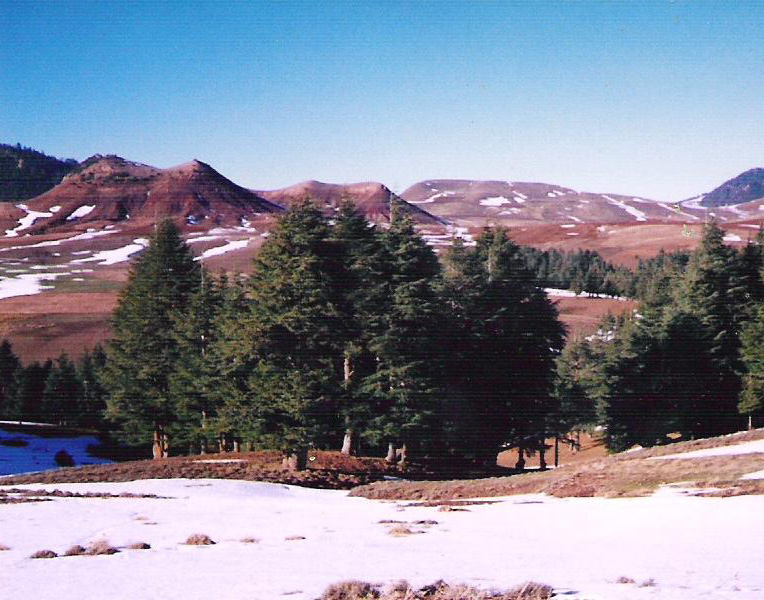- Atlas Cedar
Taxobox
name = Atlas Cedar
status = LR/lc | status_system = IUCN2.3

image_caption = Atlas Cedars nearKhénifra , Morocco
regnum =Plant ae
divisio =Pinophyta
classis = Pinopsida
ordo =Pinales
familia =Pinaceae
genus = "Cedrus"
species = "Cedrus libani"
variety = "C. libani" var. "atlantica"
trinomial = "Cedrus libani" var. "atlantica"
trinomial_authority = (Endl.) Hook.f.The Atlas Cedar is a
cedar native to theAtlas Mountains ofAlgeria (Tell Atlas ) andMorocco (in theRif andMiddle Atlas , and locally in theHigh Atlas ).Gaussen, H. (1964). Genre "Cedrus". Les Formes Actuelles. "Trav. Lab. For. Toulouse" T2 V1 11: 295-320] It is variously treated as a variety orsubspecies ofLebanon Cedar "Cedrus libani" var. "atlantica" (Endl.) Hook.f. or "Cedrus libani" subsp. "atlantica" (Endl.) Batt. & Trab., or as a distinct species "Cedrus atlantica" (Endl.) Manetti ex Carrière, depending on authority. Treatment as a variety or subspecies is found primarily in botanical and floristic works, [Hooker, J. D. (1862). On the Cedars of Lebanon, Taurus, Algeria and India. "Nat. Hist. Rev". 2: 11-18.] [Battander, J.-A. & Trabut, L. (1905). "Flora de l'Algérie".] Schwarz, O. (1944). Anatolica. "Feddes Repertorium" 54: 26-34.] [Browicz, K. & Zielinski, J. (1982). "Chorology of Trees and Shrubs in southwest Asia" vol. 1.] [Greuter, W., Burdet, H. M., & Long, G. (eds.), (1984). Med-Checklist – A critical inventory of vascular plants of the circum-mediterranean countries.] [Frankis, M. P. & Lauria, F. (1994). The maturation and dispersal of cedar cones and seeds. "International Dendrology Society Yearbook" 1993: 43-46.] while treatment as a species is more widespread in popular horticultural use,Walters, W. M. (1986). "European Garden Flora" Vol 1. ISBN 0-521- 24859-0.] and also in some botanical works.Farjon, A. (1990). "Pinaceae. Drawings and Descriptions of the Genera". Koeltz Scientific Books ISBN 3-87429-298-3.] [Gymnosperm database [http://www.conifers.org/pi/ce/atlantica.htm "Cedrus atlantica"] .] The discrepancy in treatment derives largely from the very narrow gene base of trees in cultivation, which gives a false impression of distinctiveness of the taxon, not borne out when the wider range of variation found in wild trees is examined.It is a medium-sized to large tree, 30–35 m (rarely 40m) tall, with a trunk diameter of 1.5–2 m. It forms forests on mountain sides at 1,370-2,200 m, often in pure forests, or mixed with
Algerian Fir ,juniper s,oak s andmaple s. It is very similar in all characters to the other varieties of Lebanon Cedar; differences are hard to discern. The mean cone size tends to be somewhat smaller (although recorded to 12 cm, only rarely over 9 cm long, compared to up to 10 cm in var. "brevifolia", and 12 cm in vars. "stenocoma" and "libani") though with considerable overlap (all can be as short as 6 cm), while the leaf length (10–25 mm) is similar that of var. "stenocoma", on average longer than var. "brevifolia" and shorter than var. "libani", but again with considerable overlap. In addition, many (but far from all) of the cultivated trees have glaucous (bluish) foliage, more downy shoots, and can have more leaves in each whorl; young trees in cultivation often have more ascending branches than many cultivated var. "libani".Cultivation and uses
It is common in cultivation in temperate climates. In garden settings it is most often the glaucous forms that are planted as
ornamental tree s. The glaucous forms may be distinguished as aCultivar Group Glauca Group. There are also fastigiate, pendulous, and golden-leaf forms in cultivation. It is useful in cultivation because it is more tolerant of dry and hot conditions than most conifers.Cedar
plantation s, mainly with "Cedrus libani" var. "atlantica", have been established in southernFrance for timber production.References
=
Wikimedia Foundation. 2010.
